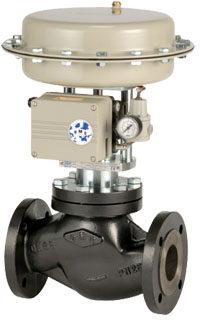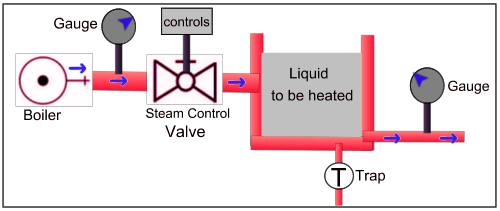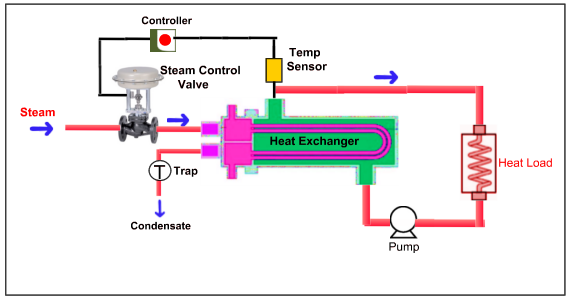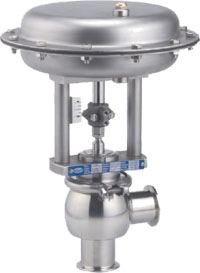 Steam Control Valve
Steam Control Valve
This article is not focused to any specific aspect of steam control valve. The wide subject matter can accommodate a lot of pages. However, to confine it within a respectable size, we will focus mostly on technicalities and industrial applications of steam control valve. We will try to make this article interesting for all readers, and navigate from basics to complex technology-oriented topics.
Let’s hit at the root of the subject, which is steam in this article.
What is Steam and what are its principal applications?
Water is converted to steam during transition from liquid to gas. Hydrogen bonds keep the H2O molecules together, and it breaks free to generate steam. In the liquid form, the molecules are continuously broken and joined with each other. The bond of the molecules becomes loose with application of heat, and eventually some molecules will break free at higher heat and create steam or dry steam. Both dry and wet steam is used in industries. Wet steam is formed when some water molecules release its’ latent heat and form tiny water droplets.
Steam is used in a large number of industrial applications. The most common applications are the process heating and driving the steam turbines to generate electricity. Apart from these, steam is used for atomization, cleaning, moisturize, and humidification. However, most of the applications will require some parameter control, and thus a steam control valve becomes a part of process control engineering.
Why a Steam Control Valve is used in process control applications?
Technically, a valve is a device which will control flow of fluid or vapor in any system. In case of steam, the major applications are to reduce the pressure of the inlet steam for process application. However, in addition to controlling pressure, a steam control valve will also control temperature.
Boilers will typically work at high pressures, as low pressure operation will result in carryover of water. High pressure steam has lower specific volume, which will allow pipes to carry less weight. In effect, distribution of steam becomes easier and cheaper due to the cost reduction in piping and insulation. Industrial process applications use steam at a lower pressure. The reason for this is that the steam at a low pressure has higher latent heat, which increases energy efficiency to a large extent. Steam pressure and temperature are related, and hence temperature is automatically controlled through the control of steam pressure. The reduction of steam pressure is also related to the required plant safety. Steam pressure can be controlled by using Steam Control Valve.
What is the principle of operation of a Steam Control Valve?
The old method of throttling flow or using an orifice plate will result in fluctuations of flow rate. The ideal solution is to adjust the downstream pressure automatically through proportional adjustment of valve opening. This technique will keep the steam pressure unaltered even during the fluctuations of flow rate.

Fig-1
The schematic in Fig-1 illustrates the use of a Steam Control Valve to reduce steam pressure to control heating inside the jacketed vessel. This system will ideally demand for manual interventions. A fully self-contained automatic system will comprise of an actuated Steam Control Valve, a pressure sensor and an actuator. This kind of system senses the fluctuations in the downstream pressure and adjusts it through a quick response actuator.
The typical mechanism to adjust the outlet pressure is through a balance of force adjustment between the steam pressure and the adjustment spring in the valve. The steam control valve is manufactured either by Non-piloted Acting Valve or Pilot-operated Acting Valve.
The non-piloted adjustment spring applies downward force directly on the main valve. The Piloted type adjustment spring executes downward pressure on a smaller pilot valve, which is not the same as the main valve.
The advantages of direct acting type are compact, economic, and straightforward installation. However, the controlling factor have larger variations from the set point, and mostly used for low loads.

Fig-2
The schematic in Fig-2 above is self-explanatory of the Piloted type Steam Control Valve arrangement normally used for a Heat Load along with a Heat Exchanger. The piloted type is used for heavy loads to achieve a fast response in a much broader range of flow range than the non-piloted types. However, these are larger in size and costlier.
What are the industrial applications of Steam Control Valves?
 Steam is the mostly used medium for heat transfer in process control applications in industries. Steam Control Vales are largely used in steam driven turbines in electric power plants. The range of applications is quite large. However, Food-processing plants, Refineries and chemical plants are the users of different types of control valves driven by steam.
Steam is the mostly used medium for heat transfer in process control applications in industries. Steam Control Vales are largely used in steam driven turbines in electric power plants. The range of applications is quite large. However, Food-processing plants, Refineries and chemical plants are the users of different types of control valves driven by steam.
Here is a list of some typical applications of this valve:
- Fluid heat exchangers
- Re-boilers
- Reactors
- Combustion air pre-heaters
- Sterilizers
- Unit Heaters
- Humidifiers
- Direct Steam Injection Sanitary Heater
- Ironers
- Acid baths
- Small storage calorifiers
- Water treatment plants
Conclusion:
We may conclude that steam control valve is a significant equipment to manufacture high-quality products in industries. Today, advanced technology and long lasting materials are used to manufacture these valves to prolong its life cycle. It is also imperative that process control engineers have to learn installation and application techniques of this important industrial equipment.
See also... our range of control valves
2-Port |
|
Low cost and CompactOMC V100: DIN rated, PN flanged control valves. Typically used for Steam, Water and Gas applications. Can be provided with Class V or Class VI shutoff. Provide compact solution with pneumatic or electric actuators and positioners. |
 |
Heavy Duty PNOMC K100: A larger range of body materials and trim capability. This range of valves is particularly suited to applications where aggresive fluids and demanding applications require control valves with exotic materials or reduced trim.
|
 |
Heavy Duty ANSIOMC KA10: True ANSI specification valves. This means that face to face dimensions as well as flanges conform to the requirements of ANSI standards. |
 |
>Hygienic |
|
Cleaning In Place (CIP) ApplicationsOMC S100: Control valve for food processing, chemical and cosmetic industries, these valves are manufactured with hygenic internals and a range of triclamp or sanitry process connections. |
 |
>On offer |
|
Northvale KortingWe have limited stock of small bore (1/2" and 1") bossmatic control valves. These are available with I/P positions and a full set of service spares |
 |
3-Port |
|
Mixing / Diverting for FlowOMC K150: 3-Port Mixing / Diverting Control Valve for flow suitable for DHW (Hot water systems, including temperature control of plate heat exchangers and calorifiers. |
 |
>Hygienic |
|
Hygienic MixingOMC S250 is used in the industrial sectors such as the food, pharmaceutical, chemical and cosmetic industries, where high hygienic standards are required.these valves are manufactured with hygenic internals and a range of triclamp or sanitry process connections. |
 |
Hygienic DivertingOMC S260 is used in the food, pharmaceutical, chemical and cosmetic industries, where high hygienic standards are required. These valves are manufactured with hygenic internals and a range of triclamp or sanitry process connections. |
 |
Comprehensive Guide to Steam Control Valves: Principles, Applications, and Industrial Use
Steam control valves play a crucial role in industrial process control, regulating steam pressure and temperature for efficient and safe operations. This article provides technical aspects, working principles, and industrial applications of steam control valves.
Understanding Steam and Its Industrial Applications
Steam is created when water transitions from liquid to gas due to heat application. The energy stored in the process of evaporating water into steam is critical in feature of its usefulness in industrial applications
Industries widely use steam for:
- Process heating – Essential for manufacturing and chemical processing.
- Power generation – Driving steam turbines to produce electricity.
- Atomization – Used in fuel combustion systems.
- Cleaning and sterilization – Found in healthcare, food processing, and industrial cleaning.
- Moisturization and humidification – Common in textile and paper production.
Since steam must be regulated for different applications, a steam control valve is essential for optimizing pressure, temperature, and flow.
Why Are Steam Control Valves Important in Process Control?
A steam control valve regulates steam flow within a system, ensuring consistent pressure and temperature for efficient operation. Boilers generate high-pressure steam for safe and cost-effective distribution, the heat of evaporation is more efficiently distribusted at lower prressures. Balancing the needs of distribution and users is therefor key to undersanding the sizing and selection of the correct control valve and the method used to control the process.
Key Functions of Steam Control Valves:
- Pressure Reduction – Ensures safe and optimal pressure levels for different processes.
- Temperature Control – Since steam pressure and temperature are directly linked, controlling pressure helps maintain the desired heat level.
- Energy Efficiency – Lower pressure steam has higher latent heat, improving overall efficiency.
- Plant Safety – Prevents excessive steam pressure, reducing the risk of equipment damage and safety hazards.
How Does a Steam Control Valve Work?
Steam control valves automatically regulate downstream pressure by adjusting the valve opening in response to demand changes.
Types of Steam Control Valves:
-
Non-Piloted (Direct Acting) Valves
- Simple, compact, and cost-effective.
- Best for low-load applications.
- May have greater pressure fluctuations.
-
Pilot-Operated Valves
- Provide rapid response and precise control for high-load applications.
- Used in heat exchangers and high-capacity systems.
- Larger and more expensive but highly efficient.
The diagram below illustrates how steam control valves function within a heat exchanger system:
(Insert relevant figure with description)
Industrial Applications of Steam Control Valves
Steam control valves are widely used across multiple industries, especially in systems requiring precise thermal regulation. Common applications include:
- Heat Exchangers – Regulating heat transfer in industrial processes.
- Re-boilers – Ensuring consistent temperature in distillation processes.
- Reactors – Maintaining optimal conditions in chemical manufacturing.
- Sterilizers – Used in medical and food processing industries.
- Humidifiers – Controlling moisture in HVAC systems.
- Steam Turbines – Powering generators in energy plants.
- Water Treatment Plants – Assisting in purification processes.
Conclusion
Steam control valves are essential for industrial efficiency, safety, and energy conservation. With advancements in materials and automation technology, these valves offer longer lifespans and enhanced performance. Process control engineers must understand proper installation, maintenance, and application to ensure optimal operation across various industries.
